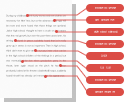哈佛大学医学院儿科教授的个人陈述
作者:互联网 来源:互联网 2014-01-08
这是哈佛大学医学院儿科教授的个人陈述,一个真实的案例,讲清楚自己做过什么很重要。
I am a practicing general pediatrician withtraining and research experience in health services research, clinical research,medical ethics, medical education, and biostatistics. As an Intern in Pediatricsat Boston Children’s Hospital I noticed the lack of intervention in cases wherea child was admitted with respiratory illness and the parents were smokers.While a junior resident I received grantfunding to carry out a clinical trial studying the delivery of a smokingcessation intervention for parental smoke rs at the time of child hospitalizationfor respiratory illness. During my senior residency, I developed the intervention,hired, trained, and supervised research staff. Also during my senior residencyI received funding to carry out a second clinical trial in the outpatientsetting that I subsequently completed during my first year of fellowship. Thesetwo landmark studies were the first to deliver smoking cessationpharmacotherapies to parents in the pediatric setting and helped expandacceptable boundaries for family-centered pediatrics to improve child health.In demonstrating that parents wanted help with smoking cessation in the contextof the child’s medical visit, I set the stage for and then drafted nationalpolicy on tobacco dependence treatment for smokers in any clinical context in which they were encountered ( AMApolicy H-490.917 Physician Responsibilities for Tobacco Cessation).
During my clinical effectiveness fellowshipI completed my coursework in year one and wrote a grant to the Robert WoodJohnson Foundation that was subsequently funded. As the PI of this study, I examinedthe implementation of a systems-level tobacco control strategy that I designedfor Neighborhood Health Plan, a Medicaid managed care organization with 127,000members. Towards the end of my fellowship I submitted a K-award to study the applicationof systems-change theory to the deliveryof effective tobacco control in settings that care for children. I was awardedthis NIH career development award as well as a young clinical scientist awardfrom the Flight Attendant Medical Research Institute (see below fordescriptions). Together these awards provided substantial research support overfive years to examine specific ways of addressing parental tobacco control inthe pediatric setting. I have also taught pediatric residents during theambulatory care rotation and see patients in the Mass General West MedicalGroup. In 2005, I was appointed Associate Fellowship Director, MGH Center forChild and Adolescent Health Policy, Harvard Pediatric Health Services ResearchFellowship Program. In that capacity I mentor between 1-3 fellows each year,helps with general program administration and direction, and attend regular fellowshipmeetings. In service to the community, I led a project that translated myresearch findings into local community health centers that had no effective tobaccocontrol programs. Within Partners, I am a member of the Tobacco Research andTreatment Center and serves on the Tobacco Control Taskforce as Co-chair of theLongitudinal Medical Record (LMR) Subcommittee. My secondhand smoke module wasdeployed in 2008 and has already been used thousands of times to provide LMRdocumentation for the presence or absence of secondhand smoke exposure ofchildren.
Outside of Partners I serve as a scientificadvisor to the Massachusetts Tobacco Control Program, and as Chair of theAmerican Academy of Pediatrics Tobacco Consortium nationally. In my TobaccoConsortium role, I help set the agenda for family-centered tobacco control inthe United States and abroad. In 2006, Iframed the annual Tobacco Consortium meeting on the topic of “no safe level” of secondhand smoke exposure, languagethat was precisely echoed at World Health Organization Tobacco Control meetingsand initiatives later that same year. Also in 2006, I was named Harvard Site PIfor the Julius Richmond Center of Excellence, Addressing the Secondhand SmokeExposure of Children. I serve as theDirector for Translational Research for the Richmond Center, helping to speedresearch findings into clinical practice and policies. My appointment to this role within theRichmond Center is a reflection of the success I have enjoyed in translating myown research findings into educational materials, programmatic trainings, and policyinitiatives. In my translational research capacity, I have served withdistinction
by drafting key tobacco control policy forthe AMA, AAP, and the APA. As part of the Richmond Center, I have a multi-yearcollaboration with researchers at Mississippi State University to use theSocial Climate Survey of Tobacco Control for policy-level manuscripts. In thiscollaboration, I design new survey items each year, writing 15abstracts,reports, and manuscripts as the results are known. This work has yielded widelydisseminated reports and manuscripts to influence the reduction of smoking inmovies and increase the use and availability of state quit lines by pediatricoffices. In 2007, I led the evaluation for an RWJF study, Author in the Room , examining novel disseminationstrategies for adopting medical innovations into practice nationally.
The program that my research team developedfrom over ten years of work is known as CEASE, the Clinical Effort AgainstSecondhand Smoke Exposure. CEASE is being used in North Carolina and Massachusetts,being evaluated in an American Legacy Foundation funded project in New York and Massachusetts, and nationally inan effectiveness trial by the NIH (R01-CA127127-01). It is available at www.ceasetobacco.organd on the national AAP website. The AAP actively disseminates the program throughpresentations of the Julius B. Richmond Center of Excellence at grand rounds andat regional and national pediatricmeetings. The materials are included in two national projects of the AmericanMedical Association f unded by the Environmental Protection Agency. In 2007, I wasnamed young investigator of the year by the Society for Research on Nicotineand Tobacco for my national research and dissemination activities in tobaccocontrol.
My research has defined and expanded thescience base for helping parents quit smoking. In one particularly notablestudy I assessed national rates of whether parents wanted to be enrolledin quit lines to help them quit smoking,finding that the majority of parents who smoke want to be enrolled in quit linesby their child’s doctor. I also showed that only one percent of parentsactually do ge t enrolled in the quit lines that are currently available in everystate. This study along with my other national studies on parental acceptanceof medications for cessation and satisfaction with pediatric invention forparental cessation helped define the state-of-the-art interventions for parentaltobacco control.
Recently, working with Surgeon Generalthrough the Interagency Committee on Smoking and Health and the Office ofSmoking and Health at the CDC, I am helping to steer national tobacco controlpolicy toward protecting children from secondhand smoke exposure in homes andautomobiles. Specifically, I helped establish a partnership with the SurgeonGeneral and the AAP on this issue. The partnership has a broad agenda thatincluded, as a first step, the dissemination of a letter from the SurgeonGeneral to every pediatrician in the AAP, alerting them to the implications forchildren of the Surgeon General’s repor t on involuntary smoking. Included inthe letter was a link to the materials of our CEASE program.
One of my current projects involvesresearching the issue of smoking in multi-unit housing. With colleagues at the AAPRichmond Center, Harvard School of Public Health, and AMA, we are pursuing publiceducation, legal ethical and social justice analysis, biochemical analysis isof children living in multi-unit housing, and national attitudes of indoor smokefree policies among those who do and do not live in multi-unit housing.
批改及润色体验馆 想知道您的作文、口语、文书将如何被我们的专家批改及润色吗? 查看更多
 马上体验口语批改
马上体验口语批改
 马上体验作文批改
马上体验作文批改
 马上体验文书润色
马上体验文书润色
作文题库:
托福-综合写作 托福-独立写作 雅思-小作文 雅思-大作文 GRE-Issue GRE-Argument GMAT-Argument SAT-Essay ACT-McGraw-Hill ACT-历年代表性作文题目考研-小作文 考研-大作文 四级-作文 六级-作文 专四-大作文 专四-小作文 专八-作文 高考-新课标一 高考-新课标二 高考-北京 高考-天津 高考-广东 高考-四川 高考-辽宁 高考-安徽 高考-福建 高考-湖南 高考-湖北 高考-陕西 高考-浙江 高考-山东 高考-上海 高考-重庆 高考-江苏 高考-江西 高考-杭州外国语学校 高考-郑州四中 高考-章丘
口语题库:
托福-Question 1 托福-Question 2 托福-Question 3 托福-Question 4 托福-Question 5 托福-Question 6 雅思-Part 1 雅思-Part 2 雅思-Part 3求职面试-500强企业高频通用英文面试题目100道 求职面试-各大企业常用场景英文面试题目
签证面签-你是谁 签证面签-你去做什么 签证面签-你有能力去做吗 签证面签-你会回来吗
留学面试-关于学校及专业 高考-高考口语
文书润色:
留学文书 学术论文 商务文书 求职文书 课程作业 书稿润色 学术论文试用 学术论文摘要使用有问题?请联系我们的在线专家
工作时间:09:00AM - 08:00PM
 专家在线
专家在线






